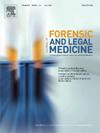对玻璃体和滑膜液进行生化分析以估算死后早期间隔:荟萃分析法。
IF 1.2
4区 医学
Q3 MEDICINE, LEGAL
引用次数: 0
摘要
由于生物体在死后会发生动态和持续的分解,因此估算死后间隔时间(PMI)是法律医学和法医学面临的一项重大挑战。通过测量死后生化标志物的浓度来估算死后间隔时间是一个很有前景的领域。本系统综述和荟萃分析旨在总结有关玻璃体(VH)和滑膜液(SF)中死后生化变化的证据,以估算早期死亡原因指数。通过对电子数据库的全面检索,我们发现了测量两种基质中死后生物标志物浓度的研究。我们的分析包括三种元分析方法:计算标准化平均差以评估生化参数的变化;执行相关元分析(ρ)以探讨这些参数与 PMI 之间的关系;以及进行元回归以得出预测模型。五项符合条件的研究结果表明,在两个矩阵中,钠水平与 PMI 之间没有相关性。然而,在 VH(ρ = 0.69;95 % CI 0.52 至 0.86)和 SF(ρ = 0.81;95 % CI 0.75 至 0.87)中,钾水平与 PMI 之间存在很强的相关性,元回归得出了 SF 的最佳预测方程:[K+] = 6.15 + 0.21 × PMI。这些发现支持将钾作为估计 PMI 的可靠生物标志物,特别是在 SF 中。本文章由计算机程序翻译,如有差异,请以英文原文为准。
Biochemical analysis of vitreous humor and synovial fluid in the estimation of early postmortem interval: A meta-analytical approach
The estimation of the postmortem interval (PMI) is a significant challenge in legal medicine and forensic sciences due to the dynamic and continuous decomposition of organisms after death. Thanatochemistry has emerged as a promising area to estimate PMI by measuring the concentrations of postmortem biochemical markers. This systematic review and meta-analysis aimed to summarize evidence on postmortem biochemical alterations in vitreous humor (VH) and synovial fluid (SF) to estimate early PMI. Comprehensive searches of electronic databases identified studies measuring postmortem biomarker concentrations in both matrices. Our analysis included three meta-analytical approaches: calculating standardized mean differences to assess variations in biochemical parameters, executing correlation meta-analysis (ρ) to explore relationships between these parameters and PMI, and conducting meta-regression to derive a predictive model. Results from five eligible studies indicated no correlation between sodium levels and PMI in both matrices. However, a strong correlation was found between potassium levels and PMI in VH (ρ = 0.69; 95 % CI 0.52 to 0.86) and SF (ρ = 0.81; 95 % CI 0.75 to 0.87), with the meta-regression yielding the optimal predictive equation for SF: [K+] = 6.15 + 0.21 × PMI. These findings support the use of potassium as a reliable biomarker for PMI estimation, particularly in SF.
求助全文
通过发布文献求助,成功后即可免费获取论文全文。
去求助
来源期刊

Journal of forensic and legal medicine
MEDICINE, LEGAL-
CiteScore
2.70
自引率
6.70%
发文量
106
审稿时长
57 days
期刊介绍:
The Journal of Forensic and Legal Medicine publishes topical articles on aspects of forensic and legal medicine. Specifically the Journal supports research that explores the medical principles of care and forensic assessment of individuals, whether adult or child, in contact with the judicial system. It is a fully peer-review hybrid journal with a broad international perspective.
The Journal accepts submissions of original research, review articles, and pertinent case studies, editorials, and commentaries in relevant areas of Forensic and Legal Medicine, Context of Practice, and Education and Training.
The Journal adheres to strict publication ethical guidelines, and actively supports a culture of inclusive and representative publication.
 求助内容:
求助内容: 应助结果提醒方式:
应助结果提醒方式:


